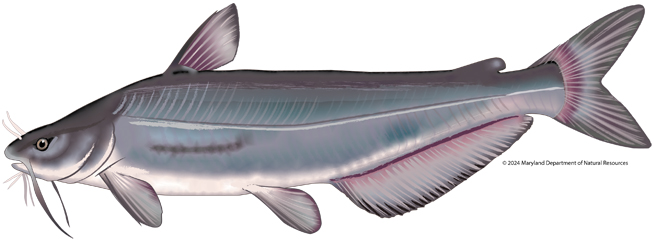| Blue Catfish |
 |
Blue Catfish |
| Ictalurus furcatus |
(A.K.A. Hump-back blue)
|
Key Distinguishing Markings:
- Blue catfish are members of the bullhead catfish family, Ictaluridae. Increasing numbers of blue catfish are being found in the tidal Potomac River.
- Catfish are long slender fish with barbels on the chin that look like long black whiskers. There are four pairs of barbels around the mouth, two on the chin, one at the angle of the mouth, and one behind the nostril.
- Blue catfish lack scales and possess an adipose fin, as well as a single, serrated spine in the dorsal and pectoral fins.
- The blue catfish is generally slate blue on the back to silvery/white on its underside and has a deeply forked tail.
- The number of anal fin rays is 30 to 35.
- The eyes of the blue catfish are placed in the lower half of the head.
View the Blue Catfish Gallery
|
Distribution:
- The native range of blue catfish extends from Minnesota and Ohio southward into Mexico. They prefer the large river basins of the Ohio, Mississippi and Missouri River drainages.
- However, due to extensive introductions, their current range includes several Atlantic drainage systems as well.
- As an introduced species, blue catfish have become very successful in the Potomac River and in several Virginia tributaries to Chesapeake Bay.
|
Size:
- Blue catfish are the largest of the catfish family in North America and can attain weights in excess of 100 pounds.
- The Maryland State record blue catfish is 84 pounds.
|
Habitat:
- Blue catfish live mainly in fresh water and are found in the tidal Potomac River. Blue catfish are not native to Maryland. They were stocked into Virginia tributaries of the Potomac River.
- Blue catfish prefer large rivers having deep channels with a swift current and a sandy bottom.
- They seek cool water in the summer and warmer waters in the winter.
|
Spawning:
- Blue catfish spawn in early summer.
- Spawning success is dependent on available cover. These fish select nest sites in dark depressions, under rocks, cavities, or undercut stream banks, or inside crevices, hollow logs, or man-made containers.
- Upon hatching, catfish fry sometimes aggregate in tight schools after leaving the nest until suitable cover is found.
- Both parent fish assist in rearing the young.
|
Fishing Tips:
- Blue catfish are very good to eat.
- Fresh baits such as cut fish, shrimp, chicken liver, and processed catfish bait are best for catching blue catfish.
- Popular methods for fishing include bait casting and bottom fishing.
|
Fun Fact:
- The sportfishing record is a specimen from Illinois that weighed 124 pounds.
- Catfish have numerous external taste buds, many of which are located on the barbels. Consequently, they can taste something by simply touching it with their barbels.
|
| Family: Ictaluridae (North American freshwater catfishes) |
| Order: Siluriformes (catfish) |
| Class: Actinopterygii (ray-finned fishes) |
For more information on blue catfish and their management, please contact Mary Groves.
Illustration by Kevin Ensor,
Maryland Department of Natural Resources,
Fishing and Boating Services
|
